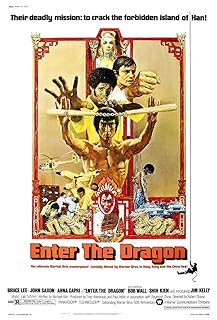電影訊息
龍爭虎鬥 [1973]--Enter the Dragon
演員: 李小龍
龙争虎斗/龙争虎斗
![]() 7.6 / 113,531人
102分鐘 | USA:99分鐘 (theatrical version) | 86分鐘 (VHS release) (USA)
7.6 / 113,531人
102分鐘 | USA:99分鐘 (theatrical version) | 86分鐘 (VHS release) (USA)
演員: 李小龍
電影評論更多影評

2012-09-17 17:55:12
The Americanized Chinese Martial Arts
Enter the Dragon and Kung Fu
—— the Americanized Chinese Martial Arts
It is said that the Chinese kung-fu communities were exclusive during the 60s. According to Herbie J Pilato, author of The "Kung Fu" Book of Caine and The "Kung Fu" Book of Wisdom, in the early 1960's, kung-fu was not known in the Western world and was denied to non-Chinese. It was taught by master/student relationships or within families, and was never revealed to non-Chinese (1). However, Bruce Lee began to teach kung-fu to non-Chinese in America since 1959 (2). His distinct manner might have aroused dissatisfaction among the Chinese community. According to Lee, in 1964 at 奧克蘭 Chinatown, the Chinese community issued an ultimatum to him to stop teaching non-Chinese. When he refused to comply, he was challenged to a combat match with Wong, a direct student of Ma Kin Fung known for his mastery of Xingyiquan and Taijiquan. The arrangement was that if Lee lost, he would have to shut down his school; while if he won, then Lee would be free to teach Caucasians or anyone else. But this is anyhow a controversial record, for Wong denied the story and stated that he requested to fight Lee after Lee issued an open challenge during one of Lee's demonstrations at a Chinatown theatre, and that Wong himself did not discriminate against Caucasians or other non-Chinese (2).
There are several recorded street fights of Lee other than this controversial private match. However, Lee didn't compete in tournaments, so literally haven't been beaten. He gains worldwide martial arts achievements, but none of them are championships of tournaments. For instance:
1964 – Karate Championship Award presented at the 1964 International Karate Championships for his 「contribution to karate.」
May 2, 1964 – Commemorative Exhibition Award presented by 華利 Jay and the Island Judo Jujitsu Club of Alameda, California in appreciation for his kung-fu exhibition.
1967 – Appreciation Award presented by 華利 Jay and the Island Judo Jujitsu Club of Alameda, California.
May 1969 – National Karate Championship Appreciation Award in appreciation of his participation as a special guest.
May 1970 – National Karate Championship Appreciation Award in appreciation of his participation as the guest of honor (3).
Therefore, people argued that Lee is a "fake master"; he did not compete because he wanted to remain mythical as a iconic figure of the eastern martial artist. While according to Scott Buendia, the President of Urban Warrior Incorporated, Bruce Lee didn't compete in the tournaments because he didn't believe in them, said they were only point sparring. Dana White of the UFC (Ultimate Fighting Championship) actually calls Bruce Lee the father of mixed martial arts because he wanted to train full contact with all ranges in. He called the tournaments of his day "dry land swimming" (4).
At that time, there were martial arts schools that had very practical style. These martial arts instructors never competed in tournaments and did not want their students to do so either, such as Lee's teacher Yip Man. Their theory is that tournaments have rules that don't allow certain actions, and when you are in the street you can not think about what is legal or not legal you must react without thinking.
No matter what reason Lee was holding for, his martial arts skill was ahead of his time, transcended the limitations imposed by various schools, hence became more international. In Enter the Dragon, Lee fights like a mixed martial arts competitor rather than a Shaolin monk. He also gives his famous speech of kung-fu concept at the beginning of the film, says "the best technique is to have no technique...the true martial artist should not be confined by styles, he must rise above them."
Shaolin kung-fu as a collection of Chinese martial arts that claim affiliation with the Shaolin Temple contains various martial arts styles, but barely anyone has tried to mix them together and "rise above them" before and after Lee comes out. Lee's saying of "the style of no style" in Enter the Dragon is not so much a Shaolin kung-fu concept as his original thoughts about philosophy and martial art, which he called Jeet Kune Do or the Way of the Intercepting Fist.
As a hollywood adaption of Chinese martial arts movie, Enter the Dragon was later to become the best of Lee's works compared with The Chinese Connection and Way of the Dragon, and one of the most popular kung-fu movies in the Western. However, the Chinese audience gives out a different star rating. They generally considered The Chinese Connection as Lee's best work (rating 8.3), with Way of the Dragon (8.1) goes the second and Enter the Dragon the last (8.0). The reason of this different is rather simple: from the first two we get stories about defeating foreigners and spreading patriotism; from Warner Bros.' Enter the Dragon, we see a classic hollywood pattern of punishing evil (whom is also a Chinese) and avenging the loved one- not saying it's less appealing, but it lacks some traditional elements of the genre.
From the historical point of view, kung-fu movie as a traditional Chinese movie genre is in a long time being considered a special artifice that conveys the social depression. Its biggest attraction lies in the way it reflects contemporary social reality and releases people's suppressed emotions by unrealistic even illogical stories. For example, Chen Zhen from The Chinese Connection is one of the most popular martial artists in Chinese kung-fu movies, and was played by Bruce Lee, Jet Li and Donnie Yen in several movies and TV series. The Chinese audiences hence worship Chen Zhen as a national hero; they barely knew Chen is a total fictional character. Yip Man, a real historical martial artist figure, has also been adapted in lots of kung-fu movies with stories about him defeating the Japanese and the British. While in history, Yip has never fight with either Japanese or whites, moreover he doesn't even have any credible battle record, and remains as mythical as his student Bruce Lee does. While they might share a same opinion towards tournaments, Yip and Lee are better stay as the Eastern renowned martial artists than national heroes, since they have no combat match record that are recognized over the world, and more importantly, they had never defeat any foreign enemy in real life. The fact of them becoming national heroes during years of kung-fu movies upsurge only proves that the contemporary China was lack of hero. Movies about them are based not on the logic of storytelling, but the pleasure of getting revenge. We always beat up foreigners in kung-fu movies, but for whom we actually have beaten?
The American's adaption of kung-fu movies however, throw out these pleasant traditional elements that could hardly please them, and add in their own cultural excitements. During the peak of Bruce Lee's career in America, Warner Bros. produced a TV series Kung Fu (1972-1975) about an adventure of a Shaolin monk. Instead of inviting Bruce Lee (whose wife later asserts that Lee created the concept for the series and was then stolen by Warner Bros.), they starred David Carradine, whom can never fight. Warner Bros. studio executive Harvey Frand says Lee wouldn't have really been appropriate for the series despite the fact that he went on to considerable success in the martial arts film world. The show needed a serene person, and Carradine was more appropriate for the role. Ed Spielman, the author of Kung Fu agrees: "I liked David in the part. One of Japan's foremost Karate champions used to say that the only qualification that was needed to be trained in the martial arts was that you had to know how to dance. And on top of being an accomplished athlete and actor, David could dance." (1). He obviously forgot that the only competition the mysterious Lee competed in was a dance competition, which he won (1958 – recognized as the 「Crown Colony Cha-Cha Champion」 in Hong Kong – 18 years old).
The narrative part of hollywood kung-fu movie was also a product of the Chinese martial arts mixed with the Western Christianity concepts. Choose one of the countless wise words from a Shaolin master in Kung Fu for example: 「The rabbit feels rage, the tiger, pity, the dragon, pain. All creatures, the low and the high, are one with nature. No life is insignificant.」 Here the first sentence is the translation of a famous Chinese traditional saying, while the following allegorical meaning is more like a Christianity explanation. The actual literal meaning of this idiom is, animals are hunting by hunters, hence one's death leaves the others a greater danger of being hunted, the survivors thereby cries for the upcoming death.
PS: I have to say the Kung Fu TV series are not done poorly. Instead, it is a considerate adaptation of the Chinese martial arts concepts. Some of the wise words are pretty interesting and very Chinese-like. For instance:
"Never assume that because a man has no eyes he cannot see. Close your eyes. Do you hear your own heartbeat? Do you hear the grasshopper which is at your feat?" "Old man...how is it that you hear these things?" "Young man, how is it that you do not?"
"There are two kinds of strength. The outer strength is obvious; it fades with age and succumbs to sickness. Then there is chi, the inner strength. It lasts through every heat and every cold, through old age and beyond."
"What is the best way to deal with force?" "As we prize peace and quiet above victory, there is a simple and preferred method- run away."
"You do not have to stop force. It is easier to redirect it."
"Seek rather not to contend. We know that where there is no contention, there is neither defeat nor victory."
References
1.http://en.wikipedia.org/wiki/Kung_Fu_(TV_series)
2.http://en.wikipedia.org/wiki/Bruce_Lee
3.http://bruceleefoundation.com/index.cfm/page/Achievements/pid/104.http://wiki.answers.com/Q/Did_Bruce_Lee_ever_fight_in_tournaments
評論

